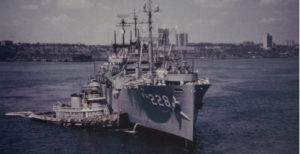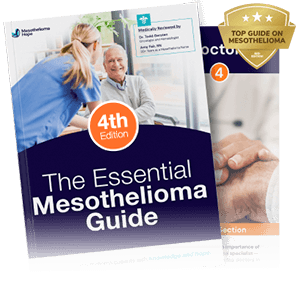Mesothelioma and Shipyard Worker Risks
 Working in a shipyard could put civilians and U.S. military veterans at risk of asbestos exposure and mesothelioma.
Working in a shipyard could put civilians and U.S. military veterans at risk of asbestos exposure and mesothelioma.
During the repair, maintenance, and manufacture of ships, shipyard workers may have come in contact with many asbestos products. Insulation, piping, and dozens of other asbestos-containing materials were used in ships between the 1930s and early 1980s.
However, asbestos exposure is now known to cause mesothelioma and other life-threatening diseases.
Once asbestos fibers enter the body, they never leave and may cause mesothelioma 10-50 years later. Many older U.S. Navy veterans and civilians who worked in shipyards decades ago are just developing mesothelioma today.
Thankfully, help is available to former shipyard workers now suffering from mesothelioma. Find out how to access medical, military, and financial resources in our Free Mesothelioma Guide.
Shipyard Workers at High Risk of Asbestos Exposure
Anyone who worked in a shipyard before the early 1980s could have been exposed to asbestos. However, certain jobs directly exposed some shipyard workers to asbestos-containing products.
Workers at risk of asbestos exposure in shipyards included:
- Boilermakers and boiler room workers
- Carpenters
- Caulkers
- Electricians
- Engine room workers
- Engineers
- Insulation workers
- Pipefitters
- Welders
Also, military personnel working in shipyards were at a particularly high risk of exposure. This is because nearly all U.S. Navy ships used asbestos for decades due to government mandates.
Because the use of asbestos in shipyards was so prevalent, one-third of mesothelioma patients today are either former shipyard workers or U.S. Navy veterans.
How Shipyard Asbestos Exposure Occurred
Many of the jobs listed above required shipyard workers to directly handle, repair, or replace asbestos-containing products. These activities could release asbestos dust into the air and workers could then easily breathe in the fibers.
During World War II, asbestos dust kicked up during shipyard work was so thick that “one often could not see across a room,” according to the New York Times. About 4.5 million people worked in shipyards in World War II, with countless more being exposed before the dangers of asbestos were publicly known.
Changing out insulation, repairing pipes, replacing gaskets and linings, working on oil tankers, and replacing pipe coverings are just a few of the tasks that could put someone at risk of asbestos exposure in a shipyard.
Secondhand Asbestos Exposure in Shipyard Family Members
Unfortunately, family members of shipyard workers could be at risk for asbestos exposure as well. Workers may have brought asbestos fibers or dust home on their clothing, tools, and other belongings.
Anyone who hugged these shipyard workers, did their laundry, or otherwise came into contact with them could develop mesothelioma later in life.
If you or a loved one worked in a shipyard and now have mesothelioma, contact our team to get the help you need. We can connect you with top doctors and financial aid to help pay for treatment.
Products With Asbestos and Shipyard Worker Risks
U.S. Navy and civilian shipyards used hundreds of asbestos products prior to learning about the health risks.
Asbestos-containing products could be found in every area of shipyard work, including ship construction, repair, and maintenance.
Common asbestos products found in shipyards included:
- Adhesive materials like seals and gaskets
- Cables and wiring for fireproofing
- Insulation used to keep boilers, pipes, pumps, and valves fireproof
- Paint used to coat ships for a fireproof protective layer
- Walls, panels, and sails for fire resistance
List of Asbestos Shipyards
Hundreds of military and civilian shipyards used asbestos prior to the early 1980s. This means almost anyone who worked at a shipyard was at risk of exposure to this cancer-causing substance.
Shipyards where asbestos exposure may have occurred include:
- Alabama Dry Dock
- Caddell Dry Dock, New York
- Mare Island Naval Shipyard, California
- Moore Dry Dock, California
- New York Shipbuilding Corporation
- Newport News Shipbuilding, Virginia
- Norfolk Naval Shipyard, Virginia
- Puget Sound Naval Shipyard, Washington
- Rough & Ready Island Ship Repair
- San Francisco Dry Dock, California
Don’t see a shipyard you worked at listed? You still could have been exposed. Call (866) 608-8933 to learn more.
Is Asbestos Still a Risk to Shipyard Workers?
Yes. While new civilian and U.S. Navy ships don’t contain asbestos, older vessels may still have asbestos-containing products aboard. This means asbestos still poses a risk to shipyard workers if proper precautions aren’t taken.
Though asbestos was removed from most older U.S. Navy vessels, a handful of ships still had asbestos aboard in recent times. For example, shipyard workers removed 21 tons of asbestos-based insulation from the USS Mount Whitney in 2015.
Modern-day asbestos shipyard workers must follow strict rules and regulations to stay safe.
Asbestos Product Manufacturers and Shipyards
Prior to the early 1980s, private companies that made and sold asbestos-based products hid the deadly risks from the public.
As a result, shipyard workers didn’t realize they were breathing in and swallowing a cancer-causing substance until it was too late.
Companies that sold asbestos-based shipbuilding products included:
- Bendix Corporation
- Burnham Holdings
- Exxon Corporation
- Foster Wheeler Corporation
- GAF Corporation
- Johns Manville
- Keasbey & Mattison
- Owens Corning
This is just a partial list of asbestos manufacturers that could have put shipyard workers at risk.
Thankfully, you can take action to get financial compensation from asbestos manufacturers that harmed you. Find out how in our Free Mesothelioma Guide.
Compensation for Shipyard Workers With Mesothelioma
Shipyard workers who develop mesothelioma may be able to seek compensation to pay for medical bills and other expenses.
Compensation options for asbestos shipyard workers include:
- Asbestos trust funds: Many asbestos companies were forced to set up trust funds by the U.S. court system after filing for bankruptcy. The trusts currently contain over $30 billion to help victims. You may qualify for compensation from multiple trusts.
- Mesothelioma lawsuits: If an asbestos product manufacturer does not have a trust fund and is still in business, you may be able to sue them directly. Mesothelioma lawsuits award $1 million or more in many cases. The military won’t be sued.
- VA benefits: The U.S. Department of Veterans Affairs (VA) currently pays out nearly $4,000 a month to most qualifying veterans with mesothelioma. Free or low-cost health care services and survivor benefits are available too.
To learn which options are the best for you, get a free consultation from our team now.
Shipyard Workers and Asbestos: Get Help Now
Asbestos was rampant in shipyards for much of the 20th century, putting millions of workers at risk. Shipyard workers with mesothelioma deserve justice for this unfair exposure and compensation to cover medical bills.
Shipyard workers with mesothelioma can get help by reaching out to Mesothelioma Hope today.
We can connect you with top mesothelioma attorneys for Navy shipyard workers, skilled doctors who treat this cancer, military benefits, and other key resources.
Get our Free Mesothelioma Guide shipped overnight to see all the ways we can assist you and your family.
Shipyard Workers and Asbestos FAQs
What professions are most at risk of asbestos exposure?
The American Cancer Society has identified asbestos shipyard workers among people with the highest risk of exposure.
Government mandates required all U.S. Navy ships to be built with asbestos before the risks were widely known. Additionally, many civilian vessels also relied on asbestos-containing products.
Shipyard workers had to install, repair, and replace asbestos-containing parts aboard these vessels on a regular basis. About 1 in 3 mesothelioma cases today can be tied back to working in shipyards or serving in the U.S. Navy.
Is there asbestos in shipyards?
Yes, U.S. Navy and civilian shipyards used asbestos between the 1930s and early 1980s. It’s believed that hundreds of shipyards relied on asbestos, putting workers in danger of mesothelioma and other asbestos-caused cancers.
Further, some older ships being worked on in shipyards today could still have asbestos aboard.
What are the dangers of working in a shipyard?
Workers exposed to asbestos in shipyards may be in danger of developing lung cancer, mesothelioma, asbestosis, and other asbestos-related diseases later in life.
Asbestos is a known carcinogen (cancer-causing material) that poses many health risks for those exposed to it.
What was asbestos used for in shipyards?
Asbestos was used to make ships much more durable. Asbestos materials were highly resistant to heat, electricity, and water.
As a result, asbestos insulation, piping, gaskets, and other heat-resistant asbestos products were commonly used throughout shipyards.




